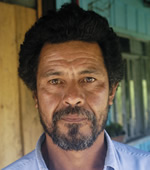 |
Odenis Bueno de Oliveira was born in 1956 in the countryside near Jaguariaíva in the state of Paraná. A descendent of Caingangue Indians, he says his great-grandmother, grandmother and mother used to make clay pots and jars. Odenis lives on a smallholding he bought in the neighbourhood, proving that the local saying “the good son always comes back home” is true. Denis Paraná – as he is known – worked in the building trade as a carpenter before starting to sculpt. In the roots and burnt tree trunks that he finds he “discovers” amongst other things, figures, beings and saints. His life has been busy, full of adventures, and it ended up taking him to Antonina (PR). He had personal troubles that led to deep depression. Going back home was his cure. “I decided to go back to my hometown. Walking in the middle of the forest I saw roots, trunks and branches. I took them home and started sculpting and carving. To cut a long story short, in 1988 I took a few pieces to Curitiba and they told me to show them to the Artists Association of Paraná. There I met a friend who didn’t want to give me his opinion, but recommended me to Adalice Araújo, an art critic, who used to be the director of the Contemporary Art Museum. I think she liked them, because she bought a piece and included me in an exhibition with other artists. The exhibition was called Visionary Artists. I didn’t understand it, but I don’t think I have visions. My work is very instinctive. It comes from within and tells others what I am.” Religion he learned from his family. “I started making my Saint Francis because everyone likes him. I confess I have made other saints because they are more commercial, but I think Francis is special. I’m lucky, because I have a friend in Ponta Grossa (PR), Dr Fabio, who collects my pieces and has a big collection of my work. It’s important, because I’ve lost many pieces. I didn’t use to sign them, so I don’t know where they are now.” Denis Paraná seems happy working at home in the middle of the forest, surrounded by his family. His pieces have a unique energy. It’s as if the burnt roots and the rock hard railway sleepers asked to be turned inside out and, freed from restrictions, transform into figures that suffer, smile, love, give birth and are strong because of their delicateness. |


